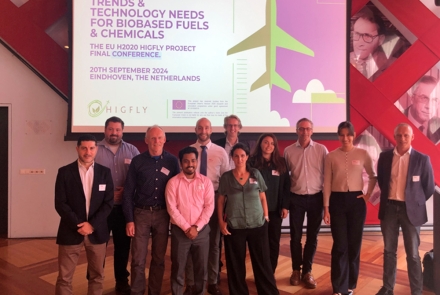3D Foam Catalytic Structures Development for the Conversion of C5 biorefinery streams
Structured catalysts and reactors have become one of the most important and commercially significant applications of reactor engineering and industrial catalysis. They can help to efficiently process large fluid flows with minimal pressure drop and can reduce hot/cold spots in reactors caused by issues such as uneven heating and cooling, poor mixing, catalyst deactivation and limitations in mass transfer rates.
Open-cell foam is a unique form of structured substrate that has higher gas solid heat and mass transfer rates which can be made of various materials, such as ceramic, metal or carbon. They can be utilised as a substrate to apply a wash-coat layer of a porous catalyst with high active phase dispersion. HIGFLY aims to develop coating protocols on various solid substrates/surfaces for catalytic chemical processes.
Wash-coating
Wash-coating is a technique used to apply a thin layer of catalyst onto the surface of a solid support material, like a foam or a pellet, which can be used to convert sugars into bio-oxygenates like furfural. The coating is made by mixing the catalyst with a binder and a solvent to form a slurry. The slurry is then applied to the surface of the support material by dipping or spraying it, and the coated material is then dried and baked to create a stable and active catalyst layer.
The quality and stability of the coating is influenced by various factors, such as the type and concentration of the binder, the solid content of the slurry, and the pH of the solution used to prepare the slurry. HIGFLY researchers aim to develop and optimise several wash-coating methods to successfully immobilise catalysts that are relevant for the synthesis of bio-oxygenates from C5 bio-refinery streams on the surface of 3D substrates. The most relevant parameters that determine the quality and stability of the coatings have been studied and sufficiently understood so that the 3D coated structures can be optimised and adjusted to meet the needs of the process.
Loading of hydrogenation catalysts
Loading of hydrogenation catalysts is a process in which a small amount of metal such as Cu, Pd, or Pt is added to a catalyst support, acting as a catalyst for hydrogenation reactions. HIGFLY researchers are testing the use of several metals on coated catalyst supports because they can activate hydrogen gas and transfer hydrogen atoms to reactant molecules, facilitating their hydrogenation, leading to improved catalytic activity and higher yields of bio-oxygenates. This process can be done on catalysts that have already been coated onto 3D substrates, making them more effective for use in the synthesis of bio-oxygenates from bio-refinery streams.
Furthermore, adding hydrogenation metals to solid catalysts supports can create bifunctional catalysts. Bifunctional catalysts have two different active sites that work together to promote a chemical reaction. One site may be responsible for adsorbing or activating the reactant molecules, while the other site facilitates the chemical reaction itself, leading to improved selectivity and activity.
Summary and Next Steps
Researchers from Eindhoven University of Technology are focusing on developing different wash-coating methods to immobilise catalysts used for synthesising bio-oxygenates from C5 bio-refinery streams. The researchers studied the critical parameters that determine the quality and stability of coatings on 3D substrates. It was found that all the wash-coating methods optimised for one material, such as alumina or zeolites, were easily adapted to other materials.
The coated foams were highly active and stable for the target reaction. The improved mass transfer rates with these structured materials were favourable for the process, and ion-exchange of an active metal catalyst resulted in highly active hydrogenation catalysts. HIGFLY researchers plan to further explore the dip-coating methodology and test other coated materials in the flow reactor under biphasic conditions. The optimised coating methodology will be adjusted to coat the optimum catalyst for the synthesis of targeted bio-oxygenates.







